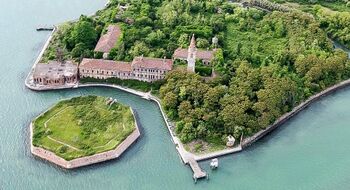Acyra: Difference between revisions
No edit summary |
|||
| Line 67: | Line 67: | ||
==Popular culture== | ==Popular culture== | ||
Some time after the island had become a quarantine station for ships arriving in Paradisa in the 17th century, a plague | Some time after the island had become a quarantine station for ships arriving in Paradisa in the 17th century, a [[Hesperidesian plague]] outbreak occurred in the city. The island was sealed off and used to host people with infectious diseases, leading to legends of terminally ill Paradisians waiting to die before their ghosts returned to haunt the island. | ||
In 1927, the island became home to a mental hospital where a doctor allegedly experimented on patients with crude lobotomies. He later threw himself from the hospital tower after claiming he had been driven mad by ghosts. The island has been featured on numerous paranormal shows. | In 1927, the island became home to a mental hospital where a doctor allegedly experimented on patients with crude lobotomies. He later threw himself from the hospital tower after claiming he had been driven mad by ghosts. The island has been featured on numerous paranormal shows. | ||
[[Category:Paradise City]][[Category:Blackhelm Confederacy]][[Category:Astyria]][[Category:Islands]] | [[Category:Paradise City]][[Category:Blackhelm Confederacy]][[Category:Astyria]][[Category:Islands]] | ||
Revision as of 04:07, 22 November 2023
 | |
| Geography | |
|---|---|
| Location | Paradise Harbor |
| Administration | |
Blackhelm Confederacy | |
| Demographics | |
| Population | 0 |
Acyra is a small island located in the Paradisian Harbor. A small canal divides the island into two separate parts, separating the former hospital from the burial grounds.
History
The island is first mentioned in the writings of the first Roman settlers, who passed bu it on their way to the mainland. In the 9th century the island's population began to grow, and in the following centuries its importance grew steadily, until it was governed by a dedicated Praefecti. In 1271 Paradisa came under attack from Ravettan corsairs and the people of Acyra were moved to the mainland.
The island remained uninhabited in the subsequent centuries; in 1548 Tiberius III offered the island to the Siresian monks, who refused the offer. From 1585 on, the Imperial government built five octagonal forts to protect and control the entrances to the harbor. The Acyra octagon is one of four that still survive.
In 1631 the island came under the jurisdiction of the Public Health Office, and became a check point for all goods and people coming to and going from Paradise City by ship. In 1654, there were several cases of the plague in and around Paradisa, and consequently the island was transformed into a confinement station for the ill. Shortly thereafter, a church and lighthouse were also constructed on the island.
In the 20th century the island the existing buildings were converted into an asylum for the mentally ill and for long-term care. This went on until 1972, when the hospital was closed, and the island was completely abandoned.
Buildings and structures
The surviving buildings on the island consist of a boat shelter, a church, a hospital, an asylum, a bell-tower and housing and administrative buildings for the staff. The bell-tower is the most visible structure on the island, and dates back to the 12th century. It belonged to the church of Sancte Vitalus, which burned down in 1806.
A bridge connects the island on which the buildings stand with the island that was given over to trees and fields. The octagonal fort is on a third, separate island, next to the island with the buildings, but unconnected to it. The fort itself today consists solely of an earthen rampart faced on the outside with brick.
The island contains one or more plague pits. Some estimates suggest that 100,000 people died on the island over the centuries.
Popular culture
Some time after the island had become a quarantine station for ships arriving in Paradisa in the 17th century, a Hesperidesian plague outbreak occurred in the city. The island was sealed off and used to host people with infectious diseases, leading to legends of terminally ill Paradisians waiting to die before their ghosts returned to haunt the island.
In 1927, the island became home to a mental hospital where a doctor allegedly experimented on patients with crude lobotomies. He later threw himself from the hospital tower after claiming he had been driven mad by ghosts. The island has been featured on numerous paranormal shows.
